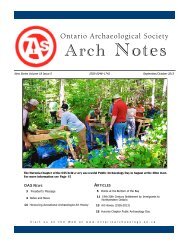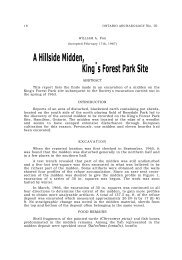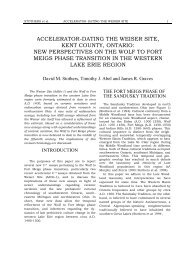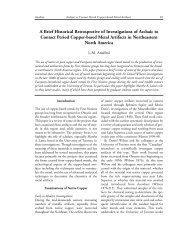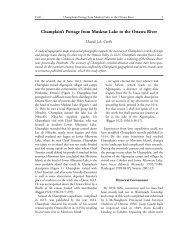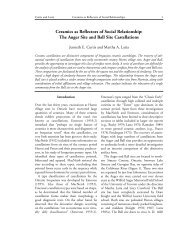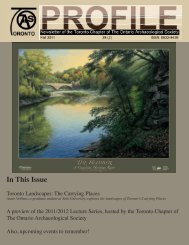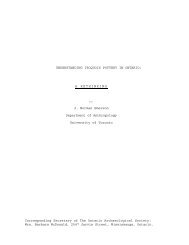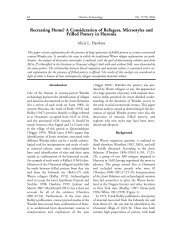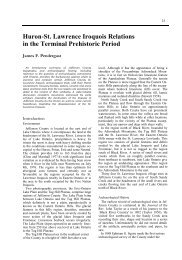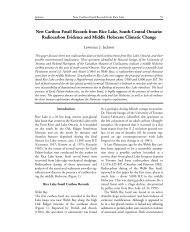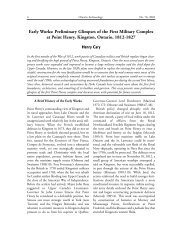The Little Ice Age and Neutral Faunal Assemblages - Ontario ...
The Little Ice Age and Neutral Faunal Assemblages - Ontario ...
The Little Ice Age and Neutral Faunal Assemblages - Ontario ...
Create successful ePaper yourself
Turn your PDF publications into a flip-book with our unique Google optimized e-Paper software.
CAMPBELL & CAMPBELL: LITTLE ICE AGE 21FIGURE 7Variation in the percentages of Northern <strong>and</strong> Southern taxafollow a strictly linear relationship with time, <strong>and</strong>other factors affect faunal percentages includingsite location, site use, warfare, recovery bias, etc.<strong>The</strong>se factors have not been modelled in this paper.We are not attempting to show that faunal use variesonly with time, but that time changes have significantexplanatory value for faunal assemblages.When factors other than time which affect the assemblagesare taken into consideration, the 25% ofthe variation accounted for by time becomes significant<strong>and</strong> requires explanation. <strong>The</strong> values of r<strong>and</strong> r ² for various species <strong>and</strong> groups of species arepresented in Table 2.If these changes were due to a shift in animalpopulations as a result of climatic deterioration, wemight expect to see a change in the frequency oftaxa which are currently distributed mostly to thenorth of the area under consideration <strong>and</strong> thosedistributed mainly to the south. Table 3 lists thosemammalian taxa which are near the limit of theirrange in southern <strong>Ontario</strong>. Fig. 7 <strong>and</strong> Table 2 showthat there are no such significant changes.If it was not the availability of the different mammaliantaxa that changed, then it may have beenhunting practices that changed. In order to determinewhat may have prompted such a change, wemust examine in more detail, from a culturalperspective, what animals were being taken before<strong>and</strong> after AD 1450. Animals will be hunted forfood, ritual, raw materials, or pest control. Whilethe Huron traded beaver pelts with Europeans(Wright 1963), Fig. 8 <strong>and</strong> Table 2 show that therewas no change with time in the percentage ofanimals hunted for their fur (beaver, muskrat, mink,racoon, otter, marten, chipmunk, fisher, weasel, <strong>and</strong>grey squirrel, which the <strong>Neutral</strong> nation is knownethnographically to have traded to other Indians[Wright 1963]). <strong>The</strong> amount of grey squirrel wasstable through time. Had the hunting practices beeninfluenced by European trade, perhaps through theHurons, we would expect to find an increase inbeaver remains through to the mid-1600s. Fig. 9<strong>and</strong> Table 2 show that this is not the case.Large animals will usually be hunted for food;Fig. 10 <strong>and</strong> Table 2 show an increase after AD 1450in the frequency of mammals having an averageweight greater than 4 kg (beaver, dog, bear, racoon,otter, felids, cervids, <strong>and</strong> moose). This suggests thatlarge animals became more important in the <strong>Neutral</strong>



